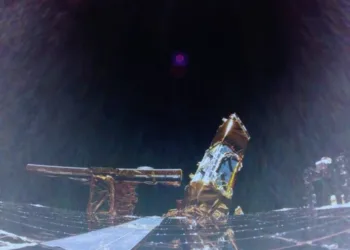The sun is a source of light and life for our planet, but it can also be quite intimidating. The inaugural image from the newly installed Visible Tunable Filter (VTF) at the Daniel K. Inouye Solar Telescope captures the sun’s surface in remarkable detail, showcasing a cluster of sunspots that resemble a scene from a horror film.
This image represents the “first light” from the VTF, indicating it is the initial complete photo taken since the device was set up. The VTF functions as an imaging spectro-polarimeter, allowing scientists to capture two-dimensional images of the sun across specific wavelengths. Unlike standard cameras, which perceive a range of wavelengths, this device isolates one wavelength at a time, finely tuning through variations of a billionth of a meter. Essentially, it’s like snapping multiple photos, each tailored to a different color.
The VTF has the capability to capture hundreds of images within mere seconds. These varying wavelengths can then be amalgamated into a comprehensive data set to create a three-dimensional representation of the object—in this instance, the sun’s surface. The image marks just the beginning of testing for this instrument, which is anticipated to be fully operational next year.
“Witnessing those initial spectral scans was surreal. This instrument achieves something that no other equipment on the telescope can—a milestone that caps months of optical alignment, testing, and collaboration across continents,” remarked Stacey Sueoka from the National Solar Observatory, which oversees the telescope. “Even with just one etalon installed, the instrument’s potential is already evident. This is only the start, and I am eager to explore what more we can accomplish as we finalize the system, integrate the second etalon, and approach the phase of scientific validation and commissioning.”
An annotated version of the image provides a depiction of the United States for scale, illustrating just how immense these sunspots are.

These sunspots are indicative of solar activity and can trigger solar flares or coronal mass ejections—massive plasma outflows that can impact Earth. As this plasma travels towards our planet, it interacts with the atmosphere in a phenomenon known as space weather. While this can lead to stunning auroras, it may also disrupt communications and create various challenges.
Instruments like those on the Inouye telescope play a crucial role in enhancing researchers’ understanding of solar activity and its influence on space weather, allowing for better forecasting in the future.





